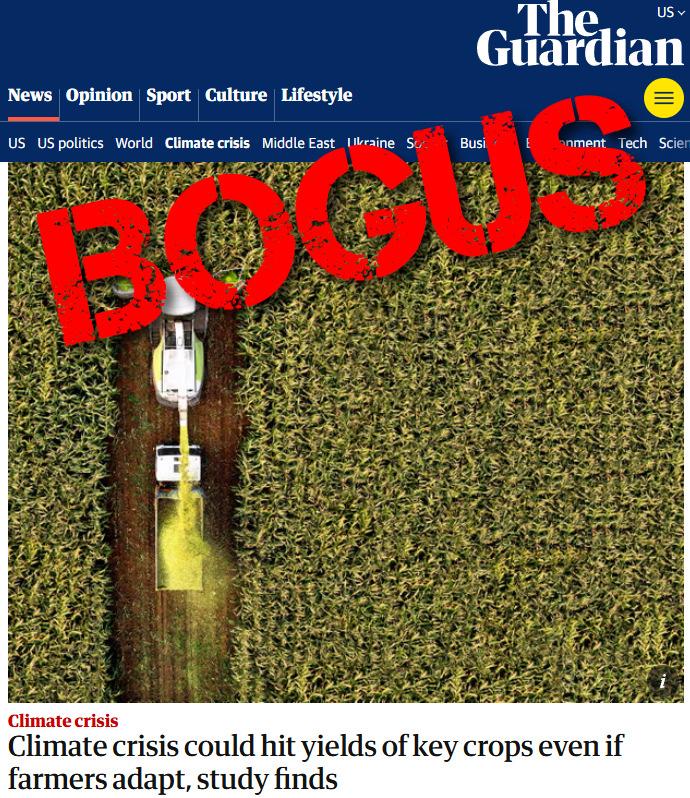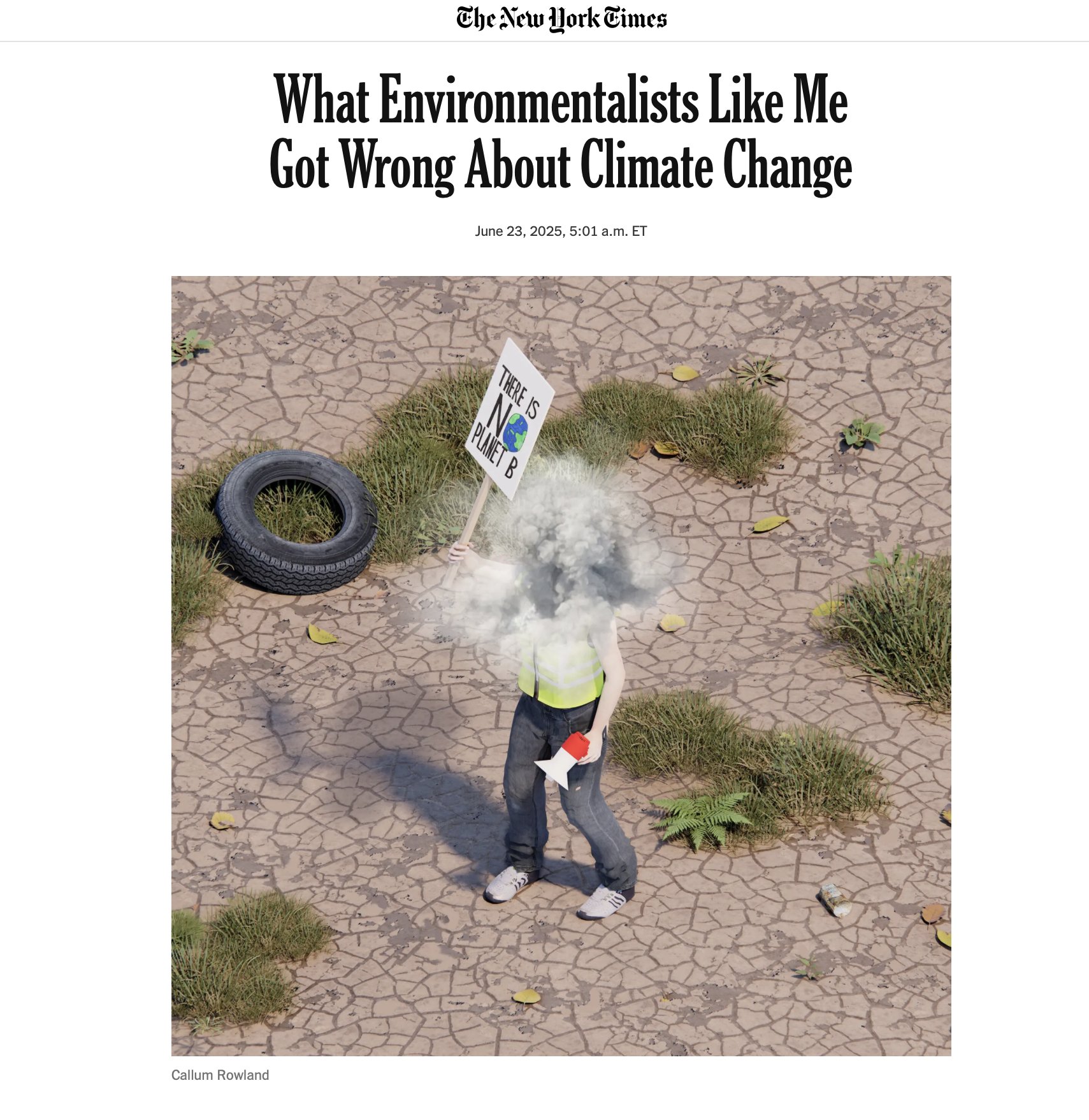To the Mainstream Media: Quit Lying About Crop Yields, They Are Increasing, Not in Decline
A number of mainstream media outlets carried stories claiming that climate change threatens crop yields and production, among them The Hill, Yahoo News, CNN, and The Guardian. That claim is refuted by everything botany, agronomy, data on crop yields, and the general greening of the Earth tell us about the effects of increased atmospheric carbon dioxide (CO2). Each of the reports cite a single study as evidence, yet its findings are flatly contradicted decades of field, laboratory, and greenhouse data showing that crop yields have risen dramatically with the general warming of the Earth since the end of the Little Ice Age in the mid-19th century, and should continue to do so in the future. In fact, world food production is at an all-time high.
The Guardian story, “Climate crisis could hit yields of key crops even if farmers adapt,” is typical of the reports issued by other outlets. They all cover the cover the same claims. The author of The Guardian‘s story, Ajit Niranjan, writes that global warming threatens to reduce staple crop production by as much as 120 calories per person, per degree of warming—even if farmers adapt.
The Guardian’s article, as with all the other media stories on the topic, reference a single new econometric study which claims to find, under various warming scenarios, average calorie yields could decline—despite rising incomes and improved agricultural practices. This study relies on an abstract, climate model-based scenario built on assumptions about future behavior, not observational data. That’s a crucial distinction.
Take, for instance, the real-world data. Cereal yields globally have increased from around 1.5 metric tons per hectare in the 1960s to over 4 tons per hectare in 2020, per U.N. Food and Agriculture Organization statistics. As Climate Realism has discussed repeatedly, “every major crop—corn, wheat, soybeans, and rice—has shown dramatic increases in productivity globally and in nearly every major producing country” since the mid-20th century.
This is not anecdotal. It is quantifiable, observable science.
Let’s look at the specific crops the article focuses on—maize, soy, rice, wheat, cassava, and sorghum. The study and the articles relying on it to produce alarming headlines claim these crops could decline of between seven and 26 percent under various warming scenarios. Yet these same crops are setting yield records year after year.
Consider maize. According to United States Department of Agriculture data, U.S. corn yields rose from 40 bushels per acre in 1950 to more than 170 bushels in 2022. Global maize yields reflect similar gains. Soybeans? The farmdoc Daily analysis shows increasing or stable yield trends in 93% of global soybean regions examined.
Even the crops most frequently cited as “vulnerable,” like sorghum and cassava, have been improving due to both conventional breeding and genetic engineering that make them more resistant to drought and pests—real climate adaptation, not hypothetical modeling.
The Guardian ignores the CO₂ effect they don’t want to talk about. Nowhere in the article does The Guardian properly discuss the so-called “CO₂ fertilization effect“—a known phenomenon where elevated atmospheric CO₂ improves plant growth through increased photosynthesis and water-use efficiency. It’s briefly acknowledged but downplayed in the study cited by The Guardian amid pessimistic projections.
As has been discussed in more than 200 articles at Climate Realism, what’s true of cereal crops is true for other types of crops, from fruits and vegetables to legumes and nuts, as well. The benefits to crops of rising CO2 has been experienced on every continent aside from Antarctica.
A 2020 study published in Nature Climate Change concluded that increased CO₂ concentrations had increased global wheat yields by 7% since the 1960s. This boost is entirely omitted in media coverage like The Guardian’s, likely because it doesn’t feed into the “climate doom” narrative.
Also, it is not just crops, rising CO2 concentrations have benefitted plant life in general contributing to a widespread greening of the Earth.
The Guardian’s article leans on a single econometric study that, even according to its own authors, represents a “pessimistic end of the spectrum” of outcomes. Jonas Jägermeyr, a co-author of the study cited in the article, cautions that “empirical impact studies are known to be overly pessimistic,” failing to capture longer-term or currently unused adaptation methods.
In fact, Jägermeyr’s own earlier 2022 study in Nature Communications found that timely adaptation in planting and harvesting could increase global crop yields by 12 percent. This fact fails to appear in The Guardian article, because it doesn’t serve the narrative.
Moreover, Andrew Hultgren, the lead author of the new study, acknowledges that adaptation will significantly soften the impact of warming, reducing projected losses by up to one-third by 2100. This suggests resilience, not catastrophe, contrary to what The Guardian implies.
One of the more theatrical claims made in the article is that global crop losses will equal “120 calories per person per day for every 1°C of warming.” This conjures up images of mass famine. But let’s unpack that. First, global food production currently exceeds caloric needs. The average global per capita caloric availability is over 2,900 calories per day —well above the recommended intake. As seen in the figure below from Our World in Data, caloric intake is directly proportional to the Gross Domestic Product (GDP) per capita of the country people live in.
The conclusion is inescapable: Carbon dioxide fertilization and economic growth and stability trump any effect climate change has had, or might have in the future.
Second, the projection assumes minimal or no breakthroughs in technology, no improved crop variants, no land-use changes, and no behavioral changes. It is a worst-case scenario built on a foundation of sand.
And that’s a favorite trick of climate reporting these days: presenting extremely bad, low-probability projections as if they’re baked-in outcomes.
The article hand-wrings over whether farmers will adapt “fast enough” to climate change—but that horse left the barn years ago. Farmers are already adapting—through better crop timing, no-till practices, improved irrigation, pest-resistant seeds, and precision agriculture.
Indeed, one of the paper’s own commentators, Ehsan Eyshi Rezaei, admits that real-world adaptation will likely land somewhere between the dire model and more optimistic studies. The Guardian didn’t highlight that. Wonder why?
More importantly, however, is what the real-world data suggests—even if no adaptation takes place at all, as the thousands of peer reviewed articles and experiments discussed at CO2 Science show—crop yields should still be expected to increase, simply on the basis of rising carbon dioxide levels, at least at any reasonably foreseeable concentrations.
This is not the first time The Guardian and other mainstream media outlets have published unfounded claims suggesting that climate change will cause agricultural decline, and it likely won’t be the last. Despite being repeatedly challenged by real-world data, they continue to peddle “crop collapse” scenarios that have not materialized in over 50 years of warming. Climate Realism has addressed this pattern repeatedly.
A common adage in science is that “extraordinary claims require extraordinary evidence.” The alarming articles published by dozens of mainstream media outlets, such as The Guardian, and the study they cite, make some pretty extraordinary claims about sharp crop yield declines, but provide no evidence, much less extraordinary evidence, to back them up. Rather, the entire narrative relies on the outputs of a single computer econometric model, which generated results that fly in the face of decades of research and thousands of studies describing the positive impact of higher CO2 levels on plant growth.
The Guardian, The Hill, CNN, and other mainstream media outlets should be ashamed of themselves for peddling previously debunked claims about crop collapse. Their latest efforts are not journalism, rather it is agenda-driven advocacy masquerading as science reporting. They’ve once again chosen to push the forecasts of a single pessimistic model as truth, while ignoring decades of hard data, contradictory findings, while failing to disclose considerable uncertainty surrounding the study’s claims. The facts are clear: crop yields are not collapsing, they are flourishing amid rising CO2 concentrations; farmers are not helpless victims of climate—they are skilled adapters; and the climate change, far from being a harbinger of food catastrophe, has coincided with the greatest increase in food production and yield increases in human history.




